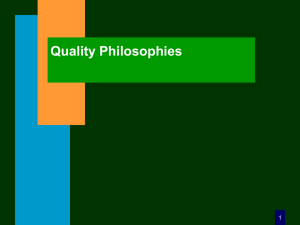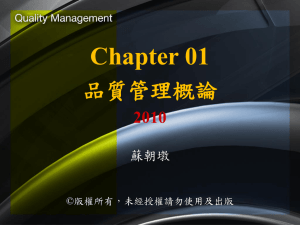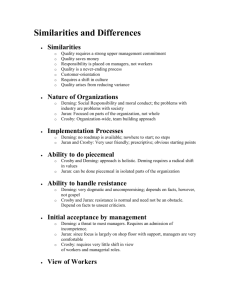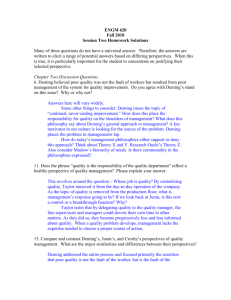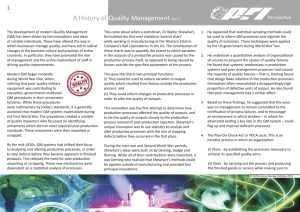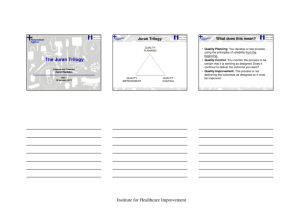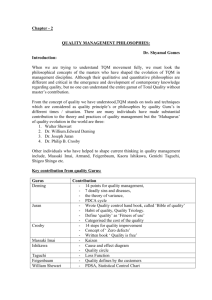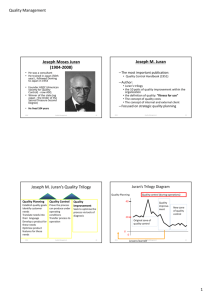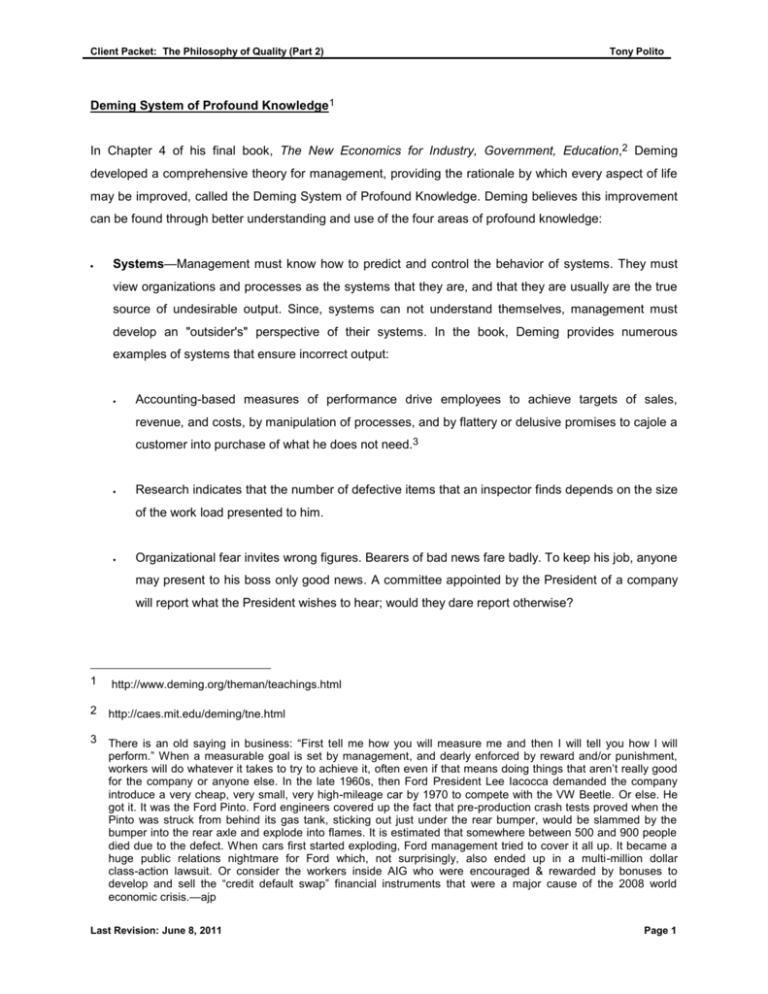
Client Packet: The Philosophy of Quality (Part 2)
Tony Polito
Deming System of Profound Knowledge1
In Chapter 4 of his final book, The New Economics for Industry, Government, Education,2 Deming
developed a comprehensive theory for management, providing the rationale by which every aspect of life
may be improved, called the Deming System of Profound Knowledge. Deming believes this improvement
can be found through better understanding and use of the four areas of profound knowledge:
Systems—Management must know how to predict and control the behavior of systems. They must
view organizations and processes as the systems that they are, and that they are usually are the true
source of undesirable output. Since, systems can not understand themselves, management must
develop an "outsider's" perspective of their systems. In the book, Deming provides numerous
examples of systems that ensure incorrect output:
Accounting-based measures of performance drive employees to achieve targets of sales,
revenue, and costs, by manipulation of processes, and by flattery or delusive promises to cajole a
customer into purchase of what he does not need.3
Research indicates that the number of defective items that an inspector finds depends on the size
of the work load presented to him.
Organizational fear invites wrong figures. Bearers of bad news fare badly. To keep his job, anyone
may present to his boss only good news. A committee appointed by the President of a company
will report what the President wishes to hear; would they dare report otherwise?
1
http://www.deming.org/theman/teachings.html
2
http://caes.mit.edu/deming/tne.html
3
There is an old saying in business: “First tell me how you will measure me and then I will tell you how I will
perform.” When a measurable goal is set by management, and dearly enforced by reward and/or punishment,
workers will do whatever it takes to try to achieve it, often even if that means doing things that aren’t really good
for the company or anyone else. In the late 1960s, then Ford President Lee Iacocca demanded the company
introduce a very cheap, very small, very high-mileage car by 1970 to compete with the VW Beetle. Or else. He
got it. It was the Ford Pinto. Ford engineers covered up the fact that pre-production crash tests proved when the
Pinto was struck from behind its gas tank, sticking out just under the rear bumper, would be slammed by the
bumper into the rear axle and explode into flames. It is estimated that somewhere between 500 and 900 people
died due to the defect. When cars first started exploding, Ford management tried to cover it all up. It became a
huge public relations nightmare for Ford which, not surprisingly, also ended up in a multi-million dollar
class-action lawsuit. Or consider the workers inside AIG who were encouraged & rewarded by bonuses to
develop and sell the “credit default swap” financial instruments that were a major cause of the 2008 world
economic crisis.—ajp
Last Revision: June 8, 2011
Page 1
Client Packet: The Philosophy of Quality (Part 2)
Tony Polito
Variation—Management should know and use the statistical theory regarding variance that explains
and predicts much systematic behavior; eg, the red bead experiment and statistical process control.
Knowledge—Deming is speaking of epistemology, the philosophical study of knowledge, how people
can correctly distinguish correct knowledge from that which is incorrect. Management should seek
new knowledge regarding their systems within the framework of the scientific method—the formulation
of hypotheses, the designing and conducting of experiments, followed by the analysis and
interpretation of the resulting data.
Psychology—Management must know human psychology, eg, how people work as teams, how they
are motivated, how they learn and transfer learning, and how their cultures, norms and taboos are
formed.4
Deming states that knowledge of one area is incomplete without understanding how the other areas
interact with it.
Other “Demingisms”
Deming also popularized a variety of other concepts, truisms and examples related to the philosophy of
quality including:
No Instant Pudding—Deming liked to say that “there is no instant pudding.” By this he meant that
there are no easy, short-term fixes to the problems facing Western organizations that continue to
practice the old ways. The days of the quick ‘n easy buck are long gone. There is no button that top
management can just push, no one-line edicts they can just issue, to make their problems go away.
Top management will have to become better leaders, have a great deal of “vision,” and work very
hard for a long, long time to solve their problems and improve their organizations.
The Folly of Pursuing Market Share—Deming said that “companies that focus on keeping their
share of the market … or getting a bigger share of the market …are on the way out.” Companies
should focus upon constantly improving the product and service they provide, focus on what
customers want, not focus on how to steal market share from competition, or, in the end, they will be
left behind. In 2002, General Motors was so obsessed with retaining at least 29 percent market share,
4
Human psychology is peculiar and must be taken into consideration toward successful decisions. Example:
Research shows bronze medalists are happier than silver medalists. Silvers regret missing the gold; bronzes are
pleased to have taken any medal at all.
Last Revision: June 8, 2011
Page 2
Client Packet: The Philosophy of Quality (Part 2)
Tony Polito
everyone was expected to be seen wearing “29” lapel pins; perhaps GM should have been more
concerned with building a better car that customers would choose to buy. In the movie Other People’s
Money, Danny DeVito exemplifies what Deming meant when he says that he bets “that the last
company in America that made buggy whips probably made the best durn buggy whips in the world,
but the automobile put them out of business.”
Forces of Destruction—Deming explained that people begin life filled with intrinsic (internal)
motivation, self-esteem, eagerness, curiosity, innovativeness, a pride in what they do, a pleasure in
working and learning … the very things that would make them good and productive employees. Think
of the child who is forever trying to make something new, who wants to show off his/her creations to
parents, who endlessly asks “why?” However, Deming says, those traits are slowly crushed over the
lifespan of an individual by “the forces of destruction,” the numerous extrinsic (external) motivators in
Western society that force people to surpress those natural behaviors … in order “to win” or “to
survive.” Those forces include artifical scarcity of grades (as if only so many As were available), gold
stars for some students and not for others, first-string athelete vs. second-string athelete (as if there
isn’t adequate opportunity for all to play), ranking of employees (as if only a certain percentage of
good workers can ever exist), artificial numerical goals that must be fulfilled before any other objective
… and pay based on incentives to meet those numerical goals. These forces induce fear,
self-defensive behavior, humiliation … and they eventually destroy those very traits a person is born
with … that would make them a much better employee. And so, in the end, individuals just submit to
doing what they have to do, and doing what they are told to do, even if it’s a bad idea, rather than
doing their best work … just so they can survive.5
Best efforts won’t do it—Deming used to ask people in the audience to stand up if they weren’t
already doing the best they could do. When no one stood up, he would explain that if everyone is
doing their best, then the problems were not coming from lack of effort, but from everyone working
hard at doing the wrong things. In fact, he would point out, best efforts “only dug deeper the hole that
we are in.” If you are trying to drive from Washington DC to New York … and you are driving south
(doing the wrong thing), then driving as fast as you can (your best driving effort) is only making things
worse. Deming meant that more vigorously a company pursued the old style of management, the
more problems it was making for itself.6
5
6
See Deming discuss this concept at http://www.youtube.com/watch?v=67B1DZlDTF4.
This is essentially a discussion of “efficiency versus effectiveness.” Peter Drucker says that efficient means
'doing things right,' effective means 'doing the right things,' and that a good manager has to do both. He agrees
with Deming’s notion of digging deeper the hole you are already in,” when he says a company is better off “doing
the right things wrong than doing the wrong things right.” Stephen Covey offers another example: swiftly climbing
a ladder that leans against the wrong wall, is efficient, but hardly effective ! Twentieth Century Western
management focused excessively on efficiency and way too little on effectiveness.
Last Revision: June 8, 2011
Page 3
Client Packet: The Philosophy of Quality (Part 2)
Tony Polito
Gadgets won’t do it—Deming was unimpressed by companies that tried to solve its problems with
excessive use of robotics, computers and other such technologies. In the 1980s, General Motors
spent almost $80 billion to “technologize” its factories (i.e., to rid itself of its “worker problems” through
robotics and automation). It is doubtful a company could build enough cars in decades to recoup such
a cost … and, besides, the strategy failed miserably. As customer preferences changed, General
Motors found it was “locked into” technology to build cars that customers didn’t want … the work
abilities of people are far more adaptive and flexible than that of robots. Besides, an organization will
always have people at its core. Will a computer make a bad demand forecaster good … or just faster
at what he/she is doing poorly? What is really needed is a change in quality—a better way to forecast,
a person better at forecasting, some new technique that is better than forecasting. Again, if a
company is doing the wrong thing, “efficient” technologies are only going to help the company “dig
deeper the hole that they are in.”
J. M. Juran 7
Joe Juran was born in Romania, raised in Minnesota, earned a BS in electrical engineering at the
University of Minnesota in 1924, and worked at the same Hawthorne plant as did Shewhart and Deming.
Juran says that his proficiency in chess, developed while at Minnesota, gave him the critical analytical
skills for resolving quality problems. During World War II, Juran vastly improved performance within the
United States Lend-Lease Department; he considers it one of his greatest achievements. Though Deming
and Juran went their separate philosophical ways in pursuit of quality after Hawthorne; both were among
those who lectured in post-war Japan. After World War II, Juran began freelance consulting and published
Juran's Quality Control Handbook (first in 1951) firmly establishing his reputation. In 1964, Juran authored
Managerial Breakthrough, in which he advocates not only control but improvement to assure quality. In
his 1986 publication, The Juran Trilogy, Juran adds planning as a third facet to achieving quality.8
A tabular look at The Trilogy reveals it parallels well other quality management/improvement concepts:
7
http://www.juran.com/lower_2.cfm?article_id=21
8
“The Juran Trilogy.” 1986. J. M. Juran. Quality Progress. 19(8): 19-24.
Last Revision: June 8, 2011
Page 4
Client Packet: The Philosophy of Quality (Part 2)
Juran’s Trilogy
Parallel Concepts
Final Inspection;
Quality Control
Inspected-In Quality
Quality Improvement
Timing
Neither
Built-in Quality
proactive.
Quality
Option
Worse. Error detected
Reactive.
Quality at the Process;
PokaYoke; Designed-In
Quality Planning
Tony Polito
far too late.
reactive
Proactive.
nor
Better. Error detected
immediately.
Best. Error cannot ever
occur at all.
For a number of years, Juran taught within the Industrial Engineering Department at New York University.
In 1979, Juran founded the Juran Institute9 to research and consult in quality improvement. Later, he
founded its associated Juran Foundation to explore the "impact of quality on society." In 1997, The Juran
Foundation became the Juran Center for Leadership in Quality at The University of Minnesota's Carlson
School of Management.10 In 1992, Juran received the National Medal of Technology from President
George Bush. Juran passed away at the age of 103 in February, 2008. Juran's contributions to quality
include:
The "80:20" rule—Nineteenth-century Italian economist Vilfredo Pareto observed that twenty percent
of the Italian people owned eighty percent of their country's wealth.11 In 1954, Juran adapted the
concept to quality improvement, stating that 80% of quality losses are effected by 20% of all root
causes. He called that 20% the 'vital few,' and the rest the 'trivial many (or useful many).'12 The
concept suggests that management resources are best allocated towards modification of the 'vital
few.'
The "80:20" rule reappears often in social sciences:
From the items available on a typical restaurant menu, 80% of revenue comes from 20%
of the items. The same is true of many product lines.
Research reveals the average American home receives 119 TV channels, yet tends to
watch mostly about 16 of them.
9
http://www.juran.com
10 http://www.csom.umn.edu/Page1260.aspx
11 Cours d'economie politique, 1896.
12 Universals in management planning and controlling, The Management Review, November, 1954; Quality Control
Handbook, 2nd edition, 1962, page 1-44.
Last Revision: June 8, 2011
Page 5
Client Packet: The Philosophy of Quality (Part 2)
Tony Polito
About 70% of the soft drink market belongs to Coke and Pepsi products. There are
thousands of other soft drink brands and flavors available, though you don’t see many of
them stocked on the shelves of major grocery store chains.
In a group project among college students, in the first 80% of the time allotted, only 20%
of the work is accomplished.
Though cars are offered in many colors, the vast majority sold are of the few, most
popular colors (eg, red, white, silver, black).
The concept, also often called the Pareto Principle, is the logical basis for the Pareto Chart, one of
The Seven Tools of Quality.
Quality dikes—Juran believes that when quality is continually sought, rewarded and assured, it
indirectly prevents major disasters. For example, Juran would have said that the small amount of
money that should have been spent to more closely inspect Space Shuttle tiles would have prevented
the much larger expenses that occurred with the Columbia exploded. The idea is not so different from
the old sayings that “a stitch in time saves nine” and “an ounce of prevention is worth a pound of
cure.” Juran was speaking more to managers with an accounting perspective since such quality dikes
look to them to be only an expense—monies spent for prevention are booked, but savings never
experienced are not.
Next and final customers—To Juran, the output of any process is a product, and the consumer of
that product is the customer, whether that customer is the final consumer or merely the next process
in the "customer chain." Someone who purchases a dining room table from a furniture retailer is an
external customer of the furniture company; the worker who varnishes sanded table tops is one of its
internal customers, that is, a customer of the sanding workstation. A process should ensure quality
for its customer; the perspective promotes quality control at the process and customer-driven quality.
Monitoring of supplier quality—Juran advocates supplier quality assurance through a number of
activities including customer-supplier partnerships for quality planning and support, supplier
certification for quality, requiring supplier documentation of quality efforts and results, and constant
evaluation of alternative suppliers.
Philip Crosby13
13 http://www.phillipcrosby.com
Last Revision: June 8, 2011
Page 6
Client Packet: The Philosophy of Quality (Part 2)
Tony Polito
Crosby practiced quality as he worked his way through the ranks in industry, starting as a technician in a
quality department. In the 1960's, while at Martin Marietta, Crosby coined the phrase "zero defects."
Crosby spent 14 years at ITT Corporation, where the position of Vice President of Quality—the first such
position among the Fortune 500—was created for him. In 1979, he authored the best-selling book Quality
is Free, and simultaneously founded the Philip Crosby Associates consulting firm and its Crosby Quality
College. In 1984, he authored another bestseller, Quality Without Tears. Philip Crosby Associates went
public in 1985. In 1989, he authored a third best-selling quality book, Let's Talk Quality and merged Philip
Crosby Associates into the Alexander Proudfoot Consulting firm.14 Crosby retired from quality consulting
in 1991. In 1997, he purchased back the assets of Phillip Crosby Associates and started Philip Crosby
Associates II, Inc. Crosby passed away in April, 2001. Crosby's contributions to quality include:
Executive Commitment to Quality—Like Deming, Crosby believes that executive commitment to
long-term quality initiatives is critical to success. His books, seminars and perspectives were primarily
intended to persuade top management of the advantages of quality management philosophy. The
most significant influence of Crosby was the credibility of his executive experience that served as a
catalyst for executive action towards quality within many organizations.
Zero Defects—In theory, a quality product is one that is made exactly to specifications; the product is
not acceptable unless so. Every individual and process in the organization should be committed to the
ideal goal of production to all specifications first time, every time. The perspective emphasizes
prevention of error versus detection of error.
Quality is Free—The costs associated with increasing quality will be more than compensated by the
decrease in costs due to a lack of quality. Since those cost reductions must be "earned" through
increased quality, Crosby states that "quality is free, but it is not a gift."
The Cost of Quality Formula—Crosby restates the "quality is free" premise more precisely with his
formula, Cost of Quality (COQ) = Price of Conformance (POC) + Price of Nonconformance (PONC).
Crosby suggests that managers track the Price of Nonconformance (eg, rework and scrap) to
measure organizational improvement.15
14 http://www.proudfoot-plc.com
15 While Crosby is credited with the creation of the COQ formula … and with widely popularizing the concept of
quality costs … the history of the COQ concept can be traced as far back as Juran’s 1951 Quality Handbook and
to other early quality thinkers as well.
Last Revision: June 8, 2011
Page 7
Client Packet: The Philosophy of Quality (Part 2)
Tony Polito
Genichi Taguchi16
Taguchi is a Japanese engineer who developed his quality techniques, known as Taguchi methods,
when involved in the reconstruction of the Japanese telephone system. Taguchi has been awarded three
Deming prizes and heads the American Supplier Institute. Taguchi's major contributions are:
Designs of Experiments for Quality—experimental methods that are heuristic (less than
theoretically perfect yet yield excellent results) in nature, and so provide quicker solutions.
Robust Design—Robust design advocates product specifications well beyond the expected customer
requirement to ensure customer satisfaction. This concept has formed the basis of many ‘classic’
television advertisements including:
A 1974 Sears DieHard battery that easily starts up a car that has been parked for three months in
the coldest town in America atop a frozen lake
A 1992 Lexus ES that has door, trunk and hood jambs so precisely manufactured that they can
track a ball bearing
The reverse of this concept, where a product is
designed so as to not (or exactly) meet the
minimum product specifications is termed
fragile design.
Societal Quality Loss Function—Taguchi
states that the societal cost of deviating from
the
target
specification
increases
parabolically17 with the increase in the deviation
-- in either direction. Consider a company that
advertises and supposedly produces 4 ounce
hamburgers. If the company really produces 5
1
2
3
4
5
6
Ounces of Hamburger
ounce hamburgers by mistake, then the producer loses the extra materials and resources. If the
company really produces 3 ounce hamburgers by mistake, perhaps the
16 http://www.amsup.com/BIOS/g_taguchi.html
17 ... not merely linearly (ie, as a straight line)
Last Revision: June 8, 2011
Page 8
Client Packet: The Philosophy of Quality (Part 2)
Tony Polito
company saves on materials, but 'society' loses, ie, the consumer loses the amount paid for the last
ounce of hamburger. Taguchi believes that ultimately, society will "punish" companies according to
their societal losses; the company will lose customers or lose money making uneconomic
hamburgers. The concept is similar to the economically efficient market price under supply and
demand. The parabolic nature of the function simply means that as the deviation increases, the
societal costs grow at an increasing rate; eg, if the company sells 1 ounce hamburgers by mistake,
they will lose many, many more customers than if they sell 3 ounce hamburgers by mistake -- far
more than the threefold increase in error.18
Kaoru Ishikawa 19
Kaoru Ishikawa (1916-1989) earned a Ph.D. in chemical engineering in 1939 from the University of Tokyo.
In 1949, Ishikawa developed one of the first quality control courses for JUSE (The Japanese Union of
Scientists and Engineers)20 and, from there, continued in a leadership role within the post-World War II
Japanese quality movement. In 1972, he received the Eugene L. Grant Award from The American Society
for Quality (ASQ),21 and the Walter A. Shewhart Medal in 1988. In 1993, ASQ established the Ishikawa
Medal to recognize outstanding leadership in improving the human aspects of quality. Ishikawa was on
faculty of the University of Tokyo. He also served as President of JUSE, the Japanese Society for Quality
Control as well as the International Academy for Quality, which he co-founded. He was also, as was
Deming, a recipient of the Second Order of the Sacred Treasure from Emperor Hirohito.
Ishikawa is best known for his development of the Ishikawa diagram, a root cause analysis technique
used by teams to find the real cause of a problem instead of just fixing its effects. Teams draw branches
backwards, starting with the observed problem, asking "why" to create the next branch; the process bears
strong resemblance to the truism that "one must ask "five whys" in order to find a problem." Alternate
terms are Fishbone Diagram (because the complete diagram somewhat resembles a fish skeleton) and
Cause-and-Effect Diagram. The Ishikawa Diagram is one of the Seven Tools of Quality. He is also
often credited with the development of Japanese quality (control) circles, worker teams that continually
18 Deming disagreed with this opnion. He states that the real world is filled with loss functions of many different
shapes. For example, a man who arrives a few minutes early to board an airplane has lost little but a a man who
arrives a few minutes late has lost much more! See The New Economics for Industry, Government, Education,
W. Edwards Deming, 1991, pages 217-224 for a detailed discussion.
19 http://www.asq.org/join/about/history/ishikawa.html
20 http://www.juse.or.jp/e/
21 http://www.asq.org
Last Revision: June 8, 2011
Page 9
Client Packet: The Philosophy of Quality (Part 2)
Tony Polito
identify and solve quality problems, during the early 1960s. Ishikawa believed that quality circles work
because they appeal to the democratic nature of humankind. Ishikawa also He also advocates
Company-Wide Quality Control (CWQC) or Total Quality Control (TQC). It is the "T" that differentiates
TQC from other quality concepts; TQC expects long-term top management commitment to a quality
philosophy, not just in manufacturing, but in all areas of their organization; eg, measuring the number of
correctly processed insurance claim forms or customer complaints successfully resolved. 22 The general
concept of TQC was advocated in America by Armand V. Feigenbaum in his 1961 book as well.
Taiichi Ohno
Taiichi Ohno contributed to quality through his development of the lean production system at Toyota
Motor. Lean production is based on the elimination of all muda (waste). Here, waste means both
inefficient manufacturing processes as well as the production of any unsold product. The two basic
elements of lean production are:
Kanban, "pull" and "just-in-time" methods, where manufacturing processes "upstream" are
triggered/driven by consumption, that reduce inventory and respond more directly to customer
demand.
Reduction (rather than avoidance) of changeover times that allow for smaller lot sizes, which in
turn, reduce inventory and reduce throughput times.23
Lean production, as compared to the three attributes of quality, delivers quality by:
Making products more valuable because of reducing manufacturing costs.
Making products more satisfying since its production is driven by true demand.
Making products more satisfying and valuable as they are delivered quicker under more efficient,
'streamlined' processes.
22 Tom Peters once observed a chef in a kitchen at Motorola practicing TQC, counting out chocolate chips to
ensure that each cookie contained the correct amount!
23 How does reduction of changeover time allow for smaller lot sizes? The longer the setup time, the more time
'wasted' changing from "reds" to blues." By making it quicker to change from "reds" to blues," the manufacturer
can change more often without "wasting" time. The reverse is not true: if you simply reduce the number of "reds"
you produce at a time, without reducing the setup time, the total time "wasted” by setups will only increase!
Last Revision: June 8, 2011
Page 10
Client Packet: The Philosophy of Quality (Part 2)
Tony Polito
Ohno was inspired to rethink the mass production system when visiting an American supermarket, where
customers pull from the shelves only what is needed when it is needed. Lean production has also been
addressed as the Toyota production system, kanban system, and just-in-time (JIT) system. Ohno joined
Toyoda Spinning and Weaving in 1932, transferred to Toyota Motor in 1943, rose to a directorship in
1954, and retired from a Toyota executive vice-presidency in 1978.
The Future of Quality
Today, quality management is viewed as much more than a mere “factory floor” topic. Even in this short
reading, you can see that quality experts concur there is a strong connection between the practice of
quality and our organizational & societal outcomes:
Deming’s belief that his System of Profound Knowledge provides “the rationale by which every
aspect of life may be improved”
Juran’s mission for his Juran Foundation to explore the "impact of quality on society."
Taguchi’s belief that ultimately, society will "punish" companies according to their societal losses.
Ishikawa’s and Feigenbaum’s perspective that quality philosophy should be practiced, not just in
manufacturing, but in all areas of an organization.
In fact, Ishikawa once said that he was “convinced world peace and prosperity need quality control. This is
why quality control will have to be taught and spread throughout the world.” Their outlook complements
the systematic perspective; all systems generate outputs that merely form the inputs for the nexus of
systems that comprise all of society.
Last Revision: June 8, 2011
Page 11
Client Packet: The Philosophy of Quality (Part 2)
Tony Polito
Relevant Readings
"Competing on the Eight Dimensions of Quality," David A. Garvin, Harvard Business Review,
November-December, 1987.
Dr. Deming: The American Who Taught the Japanese About Quality, Rafeal Aguayo, 1990.
Economic Control of Quality of Manufactured Product, Walter A. Shewhart, 1931.
Four Days with Dr. Deming: A Strategy for Modern Methods of Management, William J. Latsko and David
M. Saunders, 1995.
How to Operate QC Circle Activities, Kaoru Ishikawa, 1985 (English).
Introduction to Quality Engineering: Designing Quality into Products and Processes, Genichi Taguchi,
(1986 English).
Juran on Leadership for Quality: An Executive Handbook, Joe Juran, 1989.
Juran's Quality Control Handbook, Joe Juran, editor-in-chief, Frank M. Gryna, associate editor, 1988.
Just-in-Time for Today and Tomorrow, Taiichi Ohno with Setsuo Mito, 1988 (English).
Let's Talk Quality, Philip B. Crosby, 1989.
Managerial Breakthrough: A New Concept of the Manager's Job, Joe Juran, 1964.
Out of the Crisis, W. Edwards Deming, 1986.
Pinto Madness. Mother Jones. 1987. September.
QC Circle Koryo: General Principles of the QC Circle, Kaoru Ishikawa, 1980 (English).
Quality is Free: The Art of Making Quality Certain, Philip B. Crosby, 1979.
Quality Without Tears: The Art of Hassle-Free Management, Philip B. Crosby, 1984.
Last Revision: June 8, 2011
Page 12
Client Packet: The Philosophy of Quality (Part 2)
Tony Polito
Quality-Control Handbook, Joe Juran, 1951.
Statistical Method From the Viewpoint of Quality Control, Walter A. Shewhart, with the editorial assistance
of W. Edwards Deming, 1939.
The Legacy of Ishikawa, Greg Watson, Quality Progress, April, 2004. Pages 54-57.
The Machine that Changed the World: The Story of Lean Production, James P. Womack, Daniel T.
Jones, & Daniel Roos, 1990.
The New Economics for Industry, Government, Education, W. Edwards Deming, 1991.
The Toyota Production System: Beyond Large Scale Production, Taiichi Ohno, 1988.
"Total Quality Control," Armand V. Feigenbaum, Harvard Business Review, 1956.
Total Quality Control: Engineering and Management: The Technical and Managerial Field for Improving
Product, Armand V. Feigenbaum, 1961.
"What Does 'Product Quality' Really Mean?" David A. Garvin, Sloan Management Review, Fall, 1984.
What is Total Quality Control? The Japanese Way, Kaoru Ishikawa, 1985 (English).
Zen and the Art of Motorcycle Maintenance: An Inquiry into Values, Robert Pirsig, 1974.
© 1997, 2006. All rights reserved.
Last Revision: June 8, 2011
Page 13


